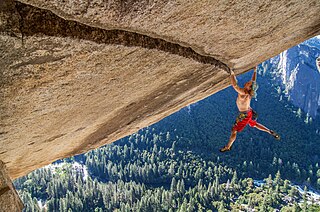
Climbing is the activity of using one's hands, feet, or other parts of the body to ascend a steep topographical object that can range from the world's tallest mountains to small boulders. Climbing is done for locomotion, sporting recreation, for competition, and is also done in trades that rely on ascension, such as rescue and military operations. Climbing is done indoors and outdoors, on natural surfaces, and on artificial surfaces
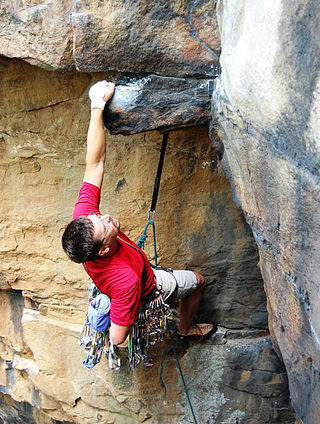
Traditional climbing is a type of free climbing in rock climbing where the lead climber places the protection equipment while ascending the route; when the lead climber has completed the route, the second climber then removes the protection equipment as they climb the route. Traditional climbing differs from sport climbing where the protection equipment is pre-drilled into the rock in the form of bolts.

A climbing route is a path by which a climber reaches the top of a mountain, or rock/ice-covered obstacle. The details of a climbing route are recorded in a climbing guidebook and/or in an online climbing route database, and will include elements such as the type of climbing route, the difficulty grade of the route–and beta on its crux(es)–and any risk or commitment grade, the length and number of pitches of the route, and the climbing equipment needed to complete the route.

Glossary of climbing terms relates to rock climbing, mountaineering, and to ice climbing.

In mountaineering and climbing, a first ascent, is the first successful documented climb to the top of a mountain or the top of a particular climbing route. Early 20th-century mountaineers and climbers focused on reaching the tops of iconic mountains and climbing routes by whatever means possible, often using considerable amounts of aid climbing, and/or with large expedition style support teams that laid "siege" to the climb.

Free climbing is a form of rock climbing in which the climber can only use climbing equipment for climbing protection, but not as an aid to help in their progression in ascending the route. Free climbing, therefore, cannot use any of the tools that are used in aid climbing to help overcome the obstacles encountered while ascending a route. The development of free climbing was an important moment in the history of rock climbing, including the concept and definition of what determined a first free ascent of a route by a climber.
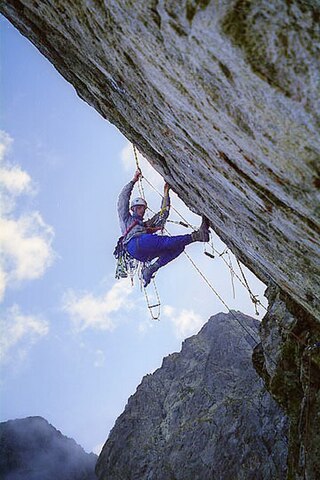
Aid climbing is a form of rock climbing that uses mechanical devices and equipment, such as aiders, for upward momentum. Aid climbing is different than free climbing, which only uses mechanical equipment for protection, but not to assist in upward momentum. Aid climbing sometimes involves hammering in pitons and bolts, into which aiders are clipped, but there is also "clean aid climbing" which avoids hammering, using only removable placements.

Sport climbing is a type of free climbing in rock climbing where the lead climber clips into pre-drilled permanent bolts for their protection while ascending a route. Sport climbing differs from the riskier traditional climbing where the lead climber has to insert temporary protection equipment while ascending.
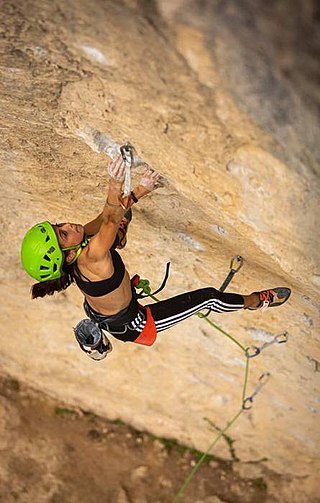
Lead climbing is a technique in rock climbing where the lead climber clips their rope to the climbing protection as they ascend a pitch of the climbing route, while their second remains at the base of the route belaying the rope to protect the lead climber in the event that they fall. The term is used to distinguish between the two roles, and the greater effort and increased risk, of the role of the lead climber.
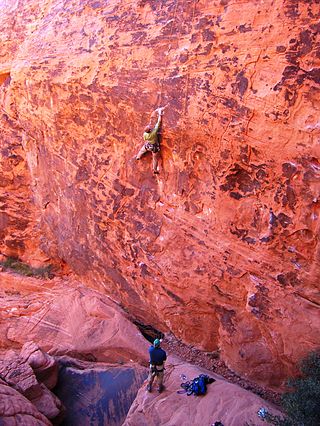
Top rope climbing is a form of rock climbing where the climber is securely attached to a climbing rope that runs through a fixed anchor at the top of the climbing route, and back down to the belayer at the base of the climb. A climber who falls will just hang from the rope at the point of the fall, and can then either resume their climb or have the belayer lower them down in a controlled manner to the base of the climb. Climbers on indoor climbing walls can use mechanical auto belay devices to top rope alone.

Rock climbing is a sport in which participants climb up, across, or down natural rock formations or indoor climbing walls. The goal is to reach the summit of a formation or the endpoint of a usually pre-defined route without falling. Rock climbing is a physically and mentally demanding sport, one that often tests a climber's strength, endurance, agility and balance along with mental control. Knowledge of proper climbing techniques and the use of specialized climbing equipment is crucial for the safe completion of routes.
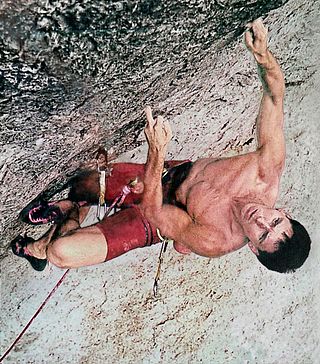
Wolfgang Güllich was a German rock climber, who is considered one of the greatest and most influential climbers in the history of the sport. Güllich dominated sport climbing after his 1984 ascent of Kanal im Rücken, the world's first-ever redpoint of an 8b (5.13d) route. He continued to set more "new hardest grade" breakthroughs than any other climber in sport climbing history, with Punks in the Gym in 1985, the world's first-ever 8b+ (5.14a), Wallstreet in 1987, the world's first-ever 8c (5.14b), and with Action Directe in 1991, the world's first-ever 9a (5.14d).
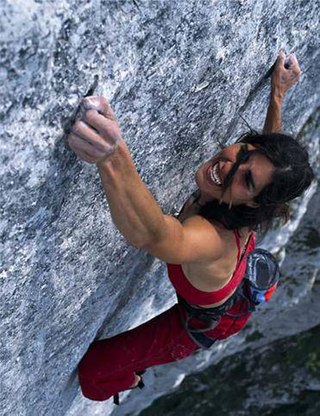
Josune Bereziartu, also known as Josune Bereciartu Urruzola, is a Basque rock climber. For a decade starting in the late 1990s, she was considered the strongest female sport climber in the world and is regarded as one of the most important female rock climbers in history.

Beta is a climbing term that designates information about how to ascend a climbing route, and the specific climbing techniques required—and how to apply them—to overcome the key challenges encountered. Traditionally sourced in climbing guidebooks, online databases and apps now provide detailed climbing beta. The term is attributed to Texan climber Jack Mileski.

In the history of rock climbing, the three main sub-disciplines—bouldering, single-pitch climbing, and big wall climbing—can trace their origins to late 19th-century Europe. Bouldering started in Fontainebleau, and was advanced by Pierre Allain in the 1930s, and John Gill in the 1950s. Big wall climbing started in the Dolomites, and was spread across the Alps in the 1930s by climbers such as Emilio Comici and Riccardo Cassin, and in the 1950s by Walter Bonatti, before reaching Yosemite where it was led in the 1950s to 1970s by climbers such as Royal Robbins. Single-pitch climbing started pre-1900 in both the Lake District and in Saxony, and by the late-1970s had spread widely with climbers such as Ron Fawcett (Britain), Bernd Arnold (Germany), Patrick Berhault (France), Ron Kauk and John Bachar (USA).
Beth Rodden is an American rock climber known for her ascents of hard single-pitch traditional climbing routes. She was the youngest woman to climb 5.14a (8b+) and is one of the only women in the world to have redpointed a 5.14c (8c+) traditional climbing graded climb. Rodden and fellow climber Tommy Caldwell were partners from 2000 to 2010, during which time they completed the second free ascent of The Nose. In 2008, Rodden made the first ascent of Meltdown, one of the hardest traditional climbs in the world and the first time in history that a female climber matched the peak of the highest climbing grades.
Didier Berthod, is a Swiss rock climber and priest. He specializes in traditional climbing, and crack climbing in particular.

Big wall climbing is a form of rock climbing that takes place on long multi-pitch routes that normally require a full day, if not several days, to ascend. In addition, big wall routes are typically sustained and exposed, where the climbers remain suspended from the rock face, even sleeping hanging from the face, with limited options to sit down or escape unless they abseil back down the whole route. It is therefore a physically and mentally demanding form of climbing.

Kurt Albert was a German climber and photographer. He started climbing at the age of 14. Before he committed himself to a career of climbing in 1986, he was a mathematics and physics teacher.

















